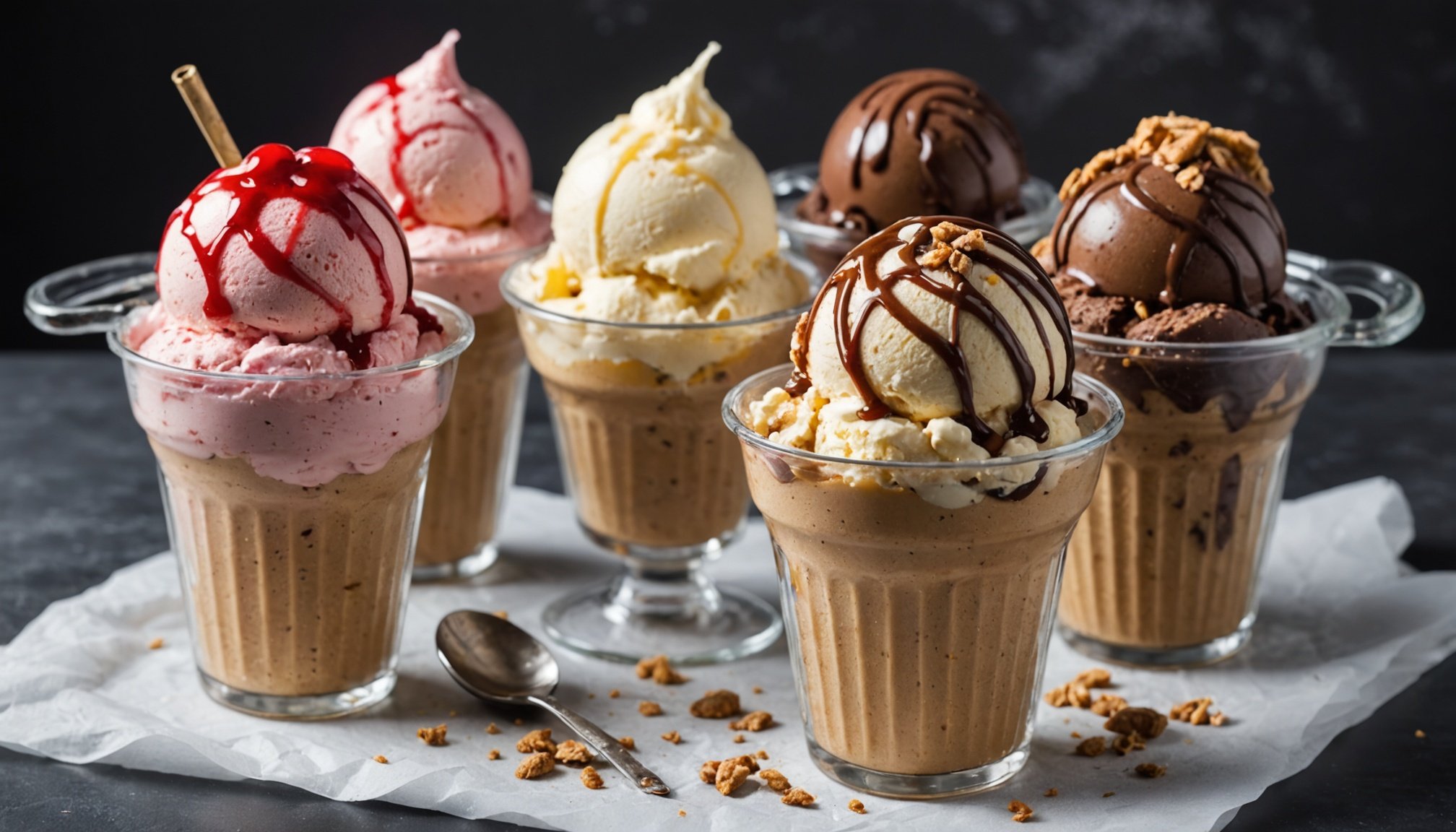Understanding Freezer Burn
Freezer burn is a common issue in food storage, especially when it comes to maintaining ice cream quality. It occurs when moisture in the food evaporates, leading to dryness and the formation of ice crystals on the surface. This affects the texture, making ice cream feel gritty or icy, and detracting from its creamy mouthfeel.
Common signs of freezer burn in ice cream include changes in color, such as a lighter or faded appearance, and the presence of hardened ice crystals. These crystals signal that the ice cream has lost moisture and, consequently, its desirable texture.
Additional reading : Transform Your Restaurant’s Interior with Reclaimed Materials: Discover the Unique Benefits Today!
The science behind freezer burn involves sublimation, where ice transitions from a solid directly to a gas, bypassing the liquid phase—a process accelerated by fluctuating temperatures and improper sealing. This sublimation leads to dehydration, affecting both the texture and taste, resulting in a product that is tough to consume and far from its original flavor profile.
To mitigate freezer burn, it is essential to focus on proper food storage techniques and maintain consistent freezer temperatures. By understanding and addressing the root causes of freezer burn, you can preserve the quality and enjoyment of your favorite frozen desserts.
Also to see : Essential Gadgets and Appliances for a Health-Focused Raw Food Restaurant Kitchen
Optimal Freezer Conditions
Maintaining consistent freezer temperatures is critical to preserving ice cream quality and preventing freezer burn. The ideal temperature for storing ice cream effectively is at or below -18°C (0°F). This specific setting ensures that the ice crystals remain small, maintaining the creamy texture that is highly sought after in ice creams.
Fluctuations in temperature can significantly impact ice cream storage. These variations can cause ice crystals to grow, leading to the dreaded gritty texture associated with freezer burn. Therefore, ensuring that your freezer’s thermostat is reliably calibrated and regularly checked can make a substantial difference.
Proper freezer setups and organization also play a vital role. Consider placing ice cream containers towards the back of the freezer, where temperatures are most stable. Avoid the freezer door, which experiences regular temperature changes due to opening and closing.
Additionally, avoid overloading the freezer, as overcrowding can hinder the appliance’s ability to maintain an even temperature, inadvertently compromising your frozen desserts.
By implementing these preservation methods, your ice cream storage efforts will enhance both the taste and texture of your favorite frozen treat, ensuring an optimal sensory experience with every scoop.
Proper Ice Cream Packaging Techniques
Effective ice cream packaging is crucial in preventing freezer burn and maintaining the dessert’s quality. The right materials can create a strong moisture barrier, keeping the creamy texture intact.
Best Packaging Materials
For the best results, opt for airtight storage containers made of durable plastic or specialty ice cream tubs. These materials are designed to resist freezer temperatures and seal in freshness. Ensure that lids fit snugly to avoid any air seepage.
Sealing Methods
Minimising air exposure is key. Consider using a layer of plastic wrap or parchment paper atop the ice cream’s surface before sealing with the lid. This extra layer acts as a protective shield against moisture loss, maintaining optimal texture.
Labeling for Freshness
Always label containers with the date of storage. Knowing when your ice cream was packaged helps in managing its shelf life. Labeling ensures that you enjoy the dessert at its peak quality, avoiding the disappointment of discovering stale or off-flavoured scoops.
By following these packaging tips, you can significantly extend the lifespan of your ice cream, preserving both its flavour and texture for future enjoyment.
Duration of Ice Cream Storage
Maintaining the ice cream shelf life involves more than just proper ice cream packaging and storage. The length of time you can store ice cream without loss of quality varies by type. For premium ice creams, a storage duration of about two to four months is typical, whereas for less dense products, the recommended timeframe is closer to one to two months.
Keep in mind that quality maintenance diminishes over time, as various factors contribute to spoilage. Homemade ice cream may have a shorter shelf life due to the absence of preservatives, requiring more cautious management. If you notice significant ice crystal formation or considerable changes in flavour, it’s a sign the ice cream should be consumed or discarded.
Factors influencing the shelf life include ingredients, air exposure, and consistent freezer temperatures. Excessive fluctuations in temperature and air exposure can hasten degradation. By monitoring these aspects and adhering to recommended timeframes, you ensure the ice cream remains at its peak quality, maximizing enjoyment and minimizing waste.
Creative Solutions for Freezer-Burned Ice Cream
When faced with freezer-burned ice cream, consider repurposing it into delightful desserts. While freezer burn affects texture and taste, clever strategies can transform these flaws into new flavour experiences.
Recipes Using Freezer-Burned Ice Cream
Cooking with notoriously gritty or dull ice cream might seem daunting. However, using it in desserts like baked goods can disguise minor freezer burn issues. Consider recipes such as ice cream bread, brownies, or even cheesecake. The altered texture becomes a non-issue, and the taste is enhanced by other ingredients.
Transforming Texture Challenges
Overcome texture problems by altering the ice cream’s state. Allow the ice cream to soften slightly, then incorporate it into a dense batter; this enhances moisture, masking dryness. Alternatively, blend freezer-burned ice cream with fresh ice cream for a smoother consistency, using a food processor for optimal results.
Smoothie and Milkshake Ideas
For a refreshing choice, mix freezer-burned ice cream with fruits or flavourful syrups to create smoothies or milkshakes. The flavours render the burn’s impact negligible, and you can benefit from the original richness without waste. Add fruits like bananas or berries to complement and intensify flavours.
Best Practices for Ice Cream Enjoyment
Revelling in the perfect cold treat involves more than just serving it straight from the freezer. Understanding serving tips can immensely elevate the sensory experience. Serve ice cream slightly softened; around -14°C is optimal, as this temperature highlights its flavour and texture more prominently. Allow ice cream to sit for a few minutes at room temperature before scooping; this ensures it reaches the ideal state without becoming excessively soft.
Proper scooping techniques are vital for the ultimate enjoyment. For the best scoop, lightly warm the scoop in hot water, then dry it and glide through the ice cream in an S-curve motion. This method, coupled with softened ice cream, yields the perfect shape and consistency, enhancing the eating experience.
Pairing flavours can significantly influence the dessert’s appeal. Experiment with complementing components, such as chocolate ice cream with a raspberry sauce, or vanilla paired with fresh mint. These pairing tips create a comprehensive sensory delight that maximizes your ice cream experience. This approach not only intensifies the flavours but also offers a delightful spin, inviting endless possibilities for enhancing everyday ice cream treats.





